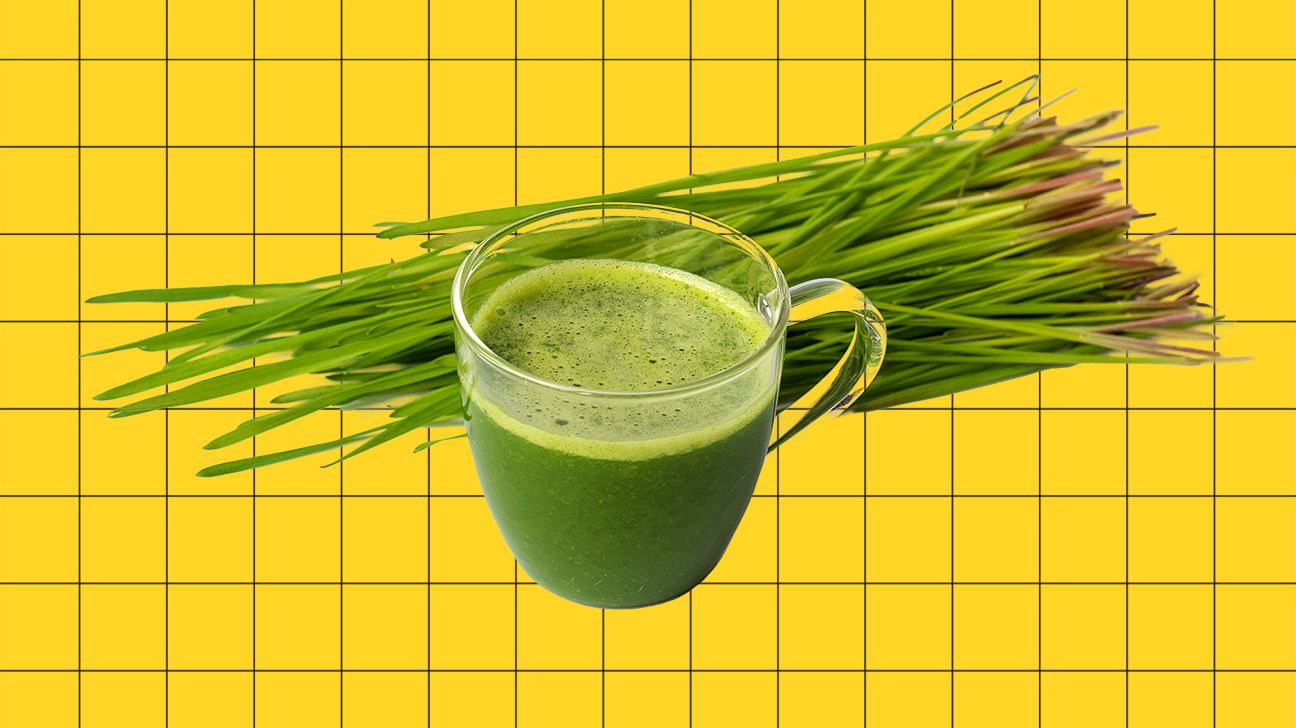You know leafy greens are super healthy. But what about green… grass?
Wheatgrass looks a lot like a lawn. But it’s not the same as the grass you’ll find in most yards. It’s actually the grass of young wheat plants, and hey, it just so happens to be packed with nutrition, which is why you often see it added to juices and smoothies or sold as supplemental powders and capsules.
But what exactly makes it so healthy? Claims about wheatgrass health benefits are a dime a dozen, and some have more evidence behind them than others. Here’s a look at 11 possible perks that are supported by science, plus what to keep in mind before giving wheatgrass a try.
It’s loaded with nutrients
Wheatgrass packs a whole lot of bang for its nutritional buck. It’s a concentrated source of vitamins, minerals, and other essentials, including:
- iron
- potassium
- vitamins A, C, and E
- magnesium
- calcium
- amino acids
- chlorophyll
- flavonoids
It can lower your overall disease risk
In general, research shows that people who eat more antioxidant-rich foods tend to have a lower disease risk overall.
And just like other green plant foods, wheatgrass is packed with antioxidant compounds — including flavonoids, chlorophyll, and vitamin C — that fight the damaging effects of free radicals and reduce inflammation.
It might help keep your weight in check
Wheatgrass is super low in calories, so it’s a great option if you’re trying to lose weight or maintain a moderate weight.
But that’s not all. Wheatgrass could also help support your overall efforts to eat healthfully and exercise, since it contains proteins and antioxidants thought to boost metabolism. In other words, it might help you burn a few extra calories.
It can help ease digestive issues
Wheatgrass has long been used as a remedy for diarrhea and other digestive issues, though there’s not much formal research backing this up.
But science does suggest that wheatgrass juice might help reduce symptoms of more serious gastrointestinal issues like ulcerative colitis. In a small 2002 study, patients who drank a wheatgrass shot daily for a month experienced a significant decrease in disease activity and rectal bleeding.
It might help wounds heal
Wheatgrass has been used topically to treat burns, ulcers, and other skin lesions, and there might be something to that remedy: The chlorophyll in wheatgrass has antibacterial properties to could help prevent infections.
Plus, chlorophyll has been shown to stimulate the production of red blood cells needed to build healthy new tissue.
It could help fight infections
Wheatgrass’s antibacterial properties may be good for more than just helping wounds heal. Some research suggests wheatgrass can be useful for treating infections that are resistant to antibiotics, as well as some types of strep throat.
It may promote healthy cholesterol
Animal studies suggest that the antioxidants in wheatgrass have the potential to fight the buildup of harmful plaque in your arteries in the face of a high fat diet.
In a 2010 study, rabbits that consumed wheatgrass for 10 weeks had lower levels of total cholesterol and higher levels of HDL (“good”) cholesterol. Will it do the same for you? There’s no way to know for sure, but adding wheatgrass to a healthy diet could help protect your heart.
It could help balance out blood sugar levels
Eating a diet with lots of fruits and vegetables and limited added sugar is a must for reducing your diabetes risk.
Animal research suggests that the enzymes in wheatgrass might be particularly beneficial for blood sugar. A 2013 study on diabetic rats found that those who were given wheatgrass daily had significantly lower blood sugar levels after just 1 month.
It can give you ~super~ blood
A small 2005 study found that wheatgrass reduced the number of blood transfusions needed in people with the blood disorder thalassemia.
Why? Experts aren’t completely sure, but they theorize that wheatgrass has compounds that could improve the quality of red blood cells.
It might fortify your immune system
Some experts say that wheatgrass has immunomodulatory properties, meaning it can stimulate or suppress your body’s immune response based on what your body needs.
There’s not much evidence to back that up, but if you want to try adding more wheatgrass to your diet during cold and flu season, it’s something most people can do without any downside.
It could protect against cancer
The antioxidants in wheatgrass appear to play a role in fighting off cancer cells.
Though the research is still quite limited, test tube studies have shown that wheatgrass can kill both mouth cancer and leukemia cells, leading some scientists to suggest that the plant could one day play a role in cancer management.
The most obvious downside to wheatgrass is that it tastes, well, like grass. But if you can handle the flavor (some people say they really like it!), it’s worth learning about the other potential side effects before you start throwing back the stuff.
- It could make your poop green. For that, you can thank wheatgrass’s sky-high levels of chlorophyll. But aside from the potential gross-out factor, it’s not dangerous.
- Think twice if you have issues with wheat. If you have a wheat allergy or gluten intolerance, wheatgrass might also be off-limits. Check with your doc before trying it.
- It could mess with your stomach a little. Wheatgrass has the potential to cause nausea or constipation, so maybe try it when you don’t have any big plans coming up.
- You should steer clear if you’re pregnant or breastfeeding. Similar to sprouts, wheatgrass has the potential to harbor illness-causing bacteria or mold.
Wheatgrass is loaded with nutrients, and limited (but promising!) research suggests it could serve up some impressive health benefits.
If you’re cool with the grassy taste, it could be a good addition to a smoothie or juice. Just be careful if you have a known issue with wheat or gluten, and avoid it if you’re pregnant or breastfeeding.

